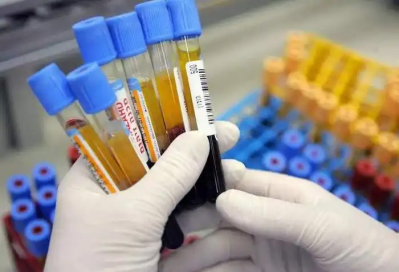Biochemical Diagnostic Raw Materials and Diagnostic Enzyme Substrates
Time:2023-12-18 Hits:207
In vitro diagnostics play a crucial role in the prevention and diagnosis of human diseases. The primary upstream raw materials in China's in vitro diagnostics industry include enzyme preparations, antigens, antibodies, among others. The competition in the in vitro diagnostic landscape, both domestically and internationally, is intensifying. To address the needs of the majority of in vitro diagnostic customers, Seebio Biotech offers cost-effective and efficient diagnostic raw materials.

Diagnostic Enzyme Substrates Introduction
Fucosidase (AFU) Detection System:
Introduction: α-L-Fucosidase (AFU) is a lysosomal acid hydrolase present in lysosomes such as the human liver, pancreas, brain, lung, and kidney fibroblasts. It primarily hydrolyzes lipids, mucins, and mucopolysaccharides containing fucose. Serum AFU levels have diagnostic significance, particularly in fucose deficiency caused by the enzyme's deficiency. Elevated AFU levels have been observed in liver cancer patients, making it a potential non-specific marker for liver cancer diagnosis.
Detection Principle: The substrate, 2-chloro-4-nitrophenyl-α-L-fucoside (CNP-AFU), undergoes hydrolysis by α-L-fucosidase in the sample, producing 2-chloro-4-nitrobenzene (CNP). The activity of AFU is determined by measuring the increase in absorbance of CNP.
CNP-α-L-Fucoside + H2O → CNP + α-L-fucoside
Main Substrates: CNP-Afu, PNP-Afu
GPDA Detection System:
Glycylproline dipeptidyl aminopeptidase (GPDA) is widely distributed in human kidneys, connective tissues, salivary glands, lymph nodes, serum, and saliva. It plays a crucial role in decomposing polypeptides derived from collagen, contributing to the maintenance of connective tissue and epithelial cell structure and function. Clinically, GPDA is employed in the auxiliary diagnosis of gastric cancer and the identification of liver metastasis production in gastric cancer, as well as in primary and secondary liver cancer.
Detection Principle: Under alkaline conditions, GPDA catalyzes the hydrolysis of the substrate glycyl-prolyl-p-nitroanilide p-toluenesulfonate (H-Gly-Pro-Pna), generating glycyl-proline and yellow p-nitroaniline. The increase in absorbance at a specific wavelength is proportional to GPDA activity.
Main Substrate: GPDA (glycyl-prolyl-p-nitroaniline-p-toluenesulfonate)
NAG-ase Detection System
The clinical use of N-acetyl-D-glucosaminidase (NAG-ase) activity measurement in urine spans over two decades. Experience has demonstrated its efficacy as a superior urinary enzyme for early detection of kidney damage.
NAG (EC3.2.1.30) is a lysosomal enzyme widely distributed in various human tissues, with high concentrations in the prostate and proximal renal tubules of the kidney. NAG's molecular weight is approximately 130-140 kDa. Normally, NAG in serum is not excreted in urine through glomerular filtration. Elevated NAG activity in urine often signals kidney damage, in addition to instances such as prostatitis and semen mixing. Measurement of the total activity of urinary NAG and its isoenzymes is a commonly employed clinical indicator.
Detection Principle (using CNP-NAG as an example): In the sample, NAG acts on the substrate 2-chloro-4-nitrobenzene-N-acetyl-β-D-glucosamine glycoside (CNP-NAG), hydrolyzing and releasing CNP in proportion to the enzyme activity within a certain range. The change in absorbance per minute (ΔA/min) can be measured at 400-405nm to calculate NAG activity. The chromophore's pKa of 5.5, close to the suitable reaction pH of 4.8 for NAG-ase, allows direct color development under reaction conditions without additional alkalinization, meeting the requirements for the rate method.
Main Substrates: CNP-NAG, PNP-NAG, MPT-NAG
Angiotensin-Converting Enzyme
Angiotensin-converting enzyme (ACE) is a zinc-containing glycoprotein functioning as a dipeptide carboxypeptidase. It converts angiotensin I to angiotensin II, causing a blood-raising effect, and the latter further constricts blood vessels, elevating blood pressure. ACE can also inactivate bradykinin, with antihypertensive effects, and potentially act on the adrenal cortex to stimulate aldosterone secretion. It plays a crucial role in the renin-aldosterone system and bradykinin system. Determining serum angiotensin I-converting enzyme activity is commonly used in diagnosing and assessing sarcoidosis.
Detection Principle: The substrate N-[3-(2-furyl)acryloyl]-L-phenylalanyl-glycyl-glycine (FAPGG) undergoes enzymatic hydrolysis by angiotensin-converting enzyme, generating FAP and GG, leading to a continuous decrease in absorbance at 340nm. ACE activity is calculated by measuring the rate of absorbance decrease of FAPGG at 340 nm.
Main Substrate: FAPGG (furanoacryloyl-phenylalanyl-glycyl-glycine)
Advantages of Diagnostic Enzymes
Quality Assurance: Seebio and Roche brands exhibit exceptional color, purity, and activity, boasting over ten years of experience and certifications from numerous in vitro diagnostic companies.
Complete Range: Each enzyme offers various corresponding substrates to meet diverse research and development needs.
Flexible Packaging: Customizable large packaging specifications are available, in addition to conventional packaging options.
For more product details, please contact us: service@seebio.cn or Phone: +86 21 58183719 or Wechat: +86 158 0195 7578
List of Enzyme Substrate Products for Biochemical Diagnostics
|
Item number
|
Brand
|
Product
|
Use
|
|
Seebio
|
H-Leu-pNA.HCl
L-Leucyl p-nitroanilide hydrochloride
|
Leucine aminopeptidase chromogenic substrate
|
|
|
Seebio
|
CNP-Afu
2-Chloro-4-nitrobenzene-a-L-fucoside
|
a-L-fucoside substrate
|
|
|
Seebio
|
M-G-CNP-Afu
MG-2-chloro-4-nitrobenzene-a-L-fucoside
|
a-L-fucoside substrate, modified complex substrate
|
|
|
Seebio
|
IPTG
Isopropyl-b-D-thiogalactopyranoside
|
b-D-galactosidase substrate
|
|
|
Seebio
|
CNP-NAG
2-Chloro-p-nitrophenyl-N-acetyl-b-D-glucosamine
|
N-acetyl-b-D-glucosidase substrate
|
|
|
Seebio
|
PNP-NAG
p-Nitrophenyl-N-acetyl-D-glucosamine
|
||
|
Seebio
|
MPT-NAG
6-Methyl-2-thiopyridine-N-acetyl-b-D-glucoside
|
||
|
Seebio
|
VRA-NAG
5-[4-(3-Methoxy-phenyl-rhodanine)]-3-ammonium acetate-N-acetamido-b-D-glucoside
|
||
|
Seebio
|
X-Gluc,CyclohexylAmmonium Salt
5-Bromo-4-chloro-3-indolyl-N-acetyl-b-D-glucosamine
|
b-Glucuronidase substrate
|
|
|
Seebio
|
Gly-Pro-Pna (GPDA)
Glycyl-prolyl-p-nitroanilide p-toluenesulfonate
|
Glycylprolyl dipeptide aminopeptidase substrate
|
|
|
Seebio
|
c-Glutamyl-3-carboxy-4-nitroaniline monoamine salt
|
c-GT substrate;c-glutamyl transpeptidase substrate
|
|
|
159830
|
Seebio
|
D-VAL-phe-lys-pna.2HCL
D-Valylalanyllysyl-p-nitroaniline dihydrochloride
|
For hemagglutination testing
|
|
Seebio
|
N-Glycyl-L-Proline
N-glycyl-L-proline
|
prolyl peptidase substrate
|
|
|
Seebio
|
PNPP
Sodium p-nitrophenylphosphate hexahydrate
|
alkaline phosphatase substrate
|
|
|
Seebio
|
FAPGG
N-[3-(2-furyl)acryloyl]-L-phenylalanyl-glycyl-glycine
|
Angiotensin peptide converting enzyme AES substrate
|
|
|
10154032103
|
Roche
|
FAD; Flavin adenine dinucleotide disodium salt hydrate
|
alanine transferase substrate
|
|
10005185103
|
Roche
|
Phosphoenolpyruvate (PEP)
|
Phosphoenolpyruvate carboxylase substrate
|
|
Seebio
|
PEP-(CHA)3 monohydrate
Phosphoenolpyruvate tris(cyclohexylamine) salt
|
||
|
DCE0538A
|
Seebio
|
Acetylthiocholine iodide
|
pseudocholinesterase substrate
|
|
Seebio
|
S-Butyrylthiocholine iodide,BTCI
|
For more product details, please contact us: service@seebio.cn or Phone: +86 21 58183719 or Wechat: +86 158 0195 7578
